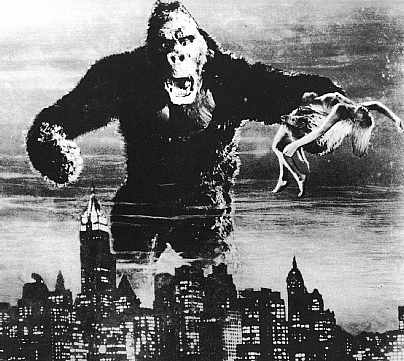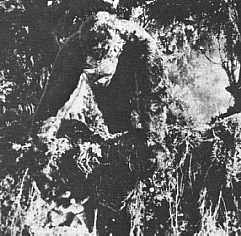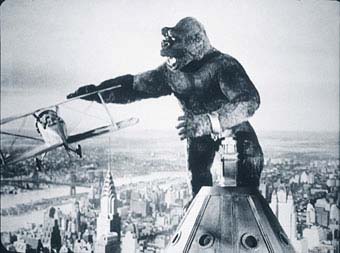|

Beauty
and the Beast: Kong,
with Wray in hand, in a publicity still.
|
The
King of Kong
At twenty-four feet in height
he was one of the biggest leading men, or more accurately primates,
of all time. Even today most people can't see the Empire State
Building without having the image of him, perched on its top,
flash into their minds. The motion picture that bares his name
is arguably the most well-known monster picture of all time:
King Kong.
Released in the spring of
1933 Kong, the story of an oversized ape captured on
a remote island in the Pacific and accidentally released on
New York City, was an immediate hit. The quality of special
effects exceeded all previous pictures and audiences sat amazed
as the giant gorilla chased actress Fay Wray through the jungles
of Skull Island, and later the concrete canyons of New York
City.
From
Lizard to Ape
The idea for the picture
came from Merian Cooper. It had formed in his mind as he was
talking with W. Douglas Burden, a noted naturalist and explorer
with the American Museum of Natural History. Burden had just
returned from a tiny island in Far East bringing with him living
examples of the largest reptiles ever found: the Komodo
Dragon. Cooper rewrote the Burden
expedition in his mind changing the lizard to an ape. Later,
along with his partner Ernest B. Schoedsack, he
produced the picture which he referred to as "the ultimate in
adventure."
|

A
back projected miniature model of Kong in bhind Wray
who is perched atop a full-sized dead tree.
|
Kong was actually an 18
inch high, poseable model, covered with rabbit hair, that was
filmed one frame at a time by stop-motion
photography artist Willis O'Brien and his crew (Despite
some stories, no man in an ape suit was ever employed to play
Kong). The Kong puppet was fimled on miniature sets of the jungle
and New York City. The stop-motion technique had been around
for over a decade and O'Brien had used in the 1925 film adaption
of Arthur Conan Doyle's dinosaur story The Lost World.
O'Brien and other special effect technicians, however, were
able to combine it with other techniques, such as rear projection
and miniature projection, to place the actors in the shots with
the miniature Kong in ways not seen before.
Special
Effects
In rear projection previously
shot footage is projected onto a translucent screen from the
rear while additional action is photographed in front of the
screen. This allows a model Tyrannosaurus Rex to menace Fay
Wray as she sits in a full, sized tree in front of the screen.
|

Kong
terrorizes a miniature projected Cabot hiding in a cave
under the cliff's edge.
|
Rear projection had been
done before, but this was the first time a cellulose-aceate
screen was used. Earlier efforts had used sand-blasted glass
to achieve the effect, but this limited the size of the surface
of the screen. The glass screen also had a noticeable "hot spot"
in the center of the projection and was a danger to the crew
should it break during production. The cellulose screen was
flexible and stretched over a frame like canvas. It also reduced
the "hot spot" by 50 percent while giving better white highlights
and more intense blacks. Sidney Saunders, who invented the new
screen, earned a special award from the Academy of Motion Picture
Arts and Sciences for the scenes shot in Kong with this
process.
Miniature projection reversed
the rear projection technique allowing full-sized actors to
appear on the miniature set. In one memorable sequence Bruce
Cabot, the male lead, hides in a cave just below the top of
a cliff. The Kong model reaches over the edge of the cliff to
grope for him in the cave. Cabot was actually filmed earlier
in a full sized cave, then projected from the rear onto a small
screen just beyond the mouth of the cave on the miniature set.
As the modelers photographed each frame of Kong's actions they
moved the film of Cabot ahead one frame also, giving the illusion
of a small man hiding from an enormous ape.
In addition, to rear and
miniature projection, an improved form of optical processing,
using a blue screen behind actors to allow them to be matted
into other footage, was used with Kong. From this point
on variations on these techniques were used in almost every
monster film until the advent of computerized image processing
in the 1990's.
Also a number of full-sized
props were used including an articulated eight foot long ape
hand in which Fay Wray was photographed. A gigantic chest and
head (with 12-inch eyeballs) was built which was used to show
actors being crunched in Kong's jaws. The latter footage was
so graphic that it was removed from the picture before release
in 1933 and was only restored recently to video copies.
|

Kong
battles an airplane on top of the miniture model of teh
Empire State Building.
|
Reception
Kong, by any standards was
a huge finacial success making approximately $2 million in its
initial release in 1933. It s credited by many as saving RKO
studios from bankruptcy. Even today, depsite its dated effects,
it is considered a masterpiece. In 1991, it was deemed
"culturally, historically and aesthetically significant" by
the Library of Congress and selected for preservation in the
National Film Registry.
The success of Kong
was not purely based on technique, though. The motion picture's
story was just as strong as it's special effects. O'Brien was
able to give the mechanical puppet a personality with which
audiences were able to identify. The giant ape's gentle fascination
with Fay Wray's character provides the centerpiece to the picture:
a tragic, at least for Kong, retelling of Beauty and the Beast.
As one character at the end of the film relates, as he stands
next to the body of the creature which has just been blasted
from the top of the Empire State Building, "It wasn't the planes
that got him, it was Beauty killed the Beast."


Copyright
1996 Lee Krystek. All Rights Reserved.